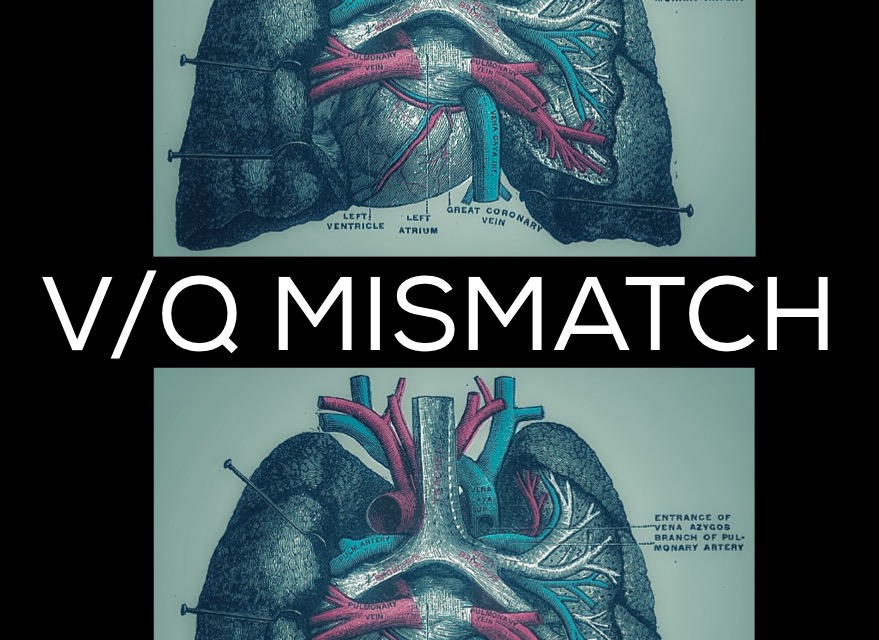V/Q Mismatch & Hypoxemia

V/Q Mismatch Confusion
V/Q mismatch is a confusing subject because the terms “dead space” and “shunt” are not very intuitive definitions. Moreover, there is a lot of confusion in textbooks and online from what I’ve seen. I read Marino’s The ICU Book and several articles on Up-to-date and came up with this outline that I think will be helpful for residents like myself.
In essence, V/Q mismatch is a spectrum: with dead space (no perfusion) and shunt (no ventilation) on either end. Some other people tell a narrative of V/Q mismatch vs. shunt (but that to me seems imprecise). Some pathologies have a primarily dead space defect problem, and therefore oxygen can help; other pathologies have a primarily shunt defect problem and therefore oxygen cannot help.
My hypoxemia pdf has the full version of these notes: http://www.henrydelrosario.com/wp-content/uploads/2016/07/Hypoxemia.pdf
Definitions
- Hypoxemia
- Definition
- Low partial pressure of oxygen (PaO2) in the blood (low level of oxygen in the blood)
- It does not always cause tissue hypoxia
- Causes
- Hypoventilation
- V/Q mismatch
- Primarily dead space defect **(often called V/Q mismatch)**
- Primarily shunt defect
- Diffusion limitation
- Reduced inspired O2 tension
- Definition
- Hypoxia
- Definition
- Insufficient oxygen to meet a tissue’s metabolic demand (low level of oxygen in a tissue or organ)
- Hypoxemia can lead to tissue hypoxia, but not always
- Definition
- Oxygenation
- Definition
- Process of oxygen diffusing from alveolus to pulmonary capillary to bind to hemoglobin or dissolve in plasma
- Definition
Causes of hypoxemia
- Hypoventilation
- Mechanism
- Lung alveolus is a space of 100% gas → if the partial pressure of one gas increases the partial pressure of another gas must decrease
- In hypoventilation there is decrease air movement → alveolar increase of carbon dioxide (PACO2) → alveolar decrease of oxygen (PAO2)
- A-a gradient is normal
- Causes
- CNS depression (drug overdose, opiates, CNS lesions)
- Obesity hypoventilation (Pickwickian) syndrome
- Impaired neural conduction (ALS, GB)
- Muscular weakness (myasthenia gravis, hypothyroidism, critical illness myopathy)
- Poor chest wall mechanics (kyphoscoliosis)
- Tx
- Responds to supplemental oxygen
- Mechanism
- V/Q mismatch
- Definition
- Imbalance of ventilation and perfusion
- A-a gradient is almost always elevated
- Causes (two opposing forms; per Marino and UpToDate: Mechanical ventilation article)
- Primarily dead space defect
- COPD, asthma, PE
- Primarily shunt defect
- PNA, pulm edema, ARDS
- Primarily dead space defect
- Normal lung
- A normal lung has V/Q mismatch: V/Q ratio is higher in the apices and lower at the bases (higher ventilation in the apices, more perfusion in the bases)
- Dead space
- Definition
- Ventilation is excessive to perfusion (V/Q >1)
- Ventilated lung but no blood flow → no gas exchange
- ***(when the pathology is of mostly dead space defects = people tend to call this simply a V/Q mismatch)***
- Memory cue: When I see DEAD, I think NO BLOOD = DEAD LUNG. There is SPACE, because alveoli are ventilated and open.
- Anatomic dead space
- Large conducting airways have no contact with capillary blood
- Pharynx, trachea
- Using a snorkel :)
- Physiologic dead space
- Poor perfusion
- PE
- Reduced blood flow (low CO)
- COPD (emphysema destroys alveolar septae and pulm capillary bed → limited blood flow to a fairly well oxygenated lung)
- Positive pressure ventilation (can inc ventilation to alveoli that do not have corresponding inc in perfusion → worsens dead space)
- Tx
- Responds to supplemental oxygen
- Definition
- Shunt
- Definition
- Ventilation is inadequate to perfusion (V/Q <1)
- When blood passes from the right to the left side of the heart without being oxygenated
- Anatomic shunts
- When blood bypasses alveoli
- Can cause extreme V/Q mismatch (V/Q=0)
- Intracardiac shunts (ASD, VSD), AVMs
- Physiologic shunts
- When non-ventilated alveoli are perfused
- Atelectasis
- Disease with alveolar filling (PNA, pulm edema, ARDS)
- Obesity
- Tx
- DOES NOT respond to supplemental oxygen
- Blood is not in contact with an alveolar membrane that can exchange oxygen → so breathing 100% will not correct hypoxemia
- ICU
- Particularly in the ICU, for ARDS, a shunt is created where lungs are perfused but ventilation is limited due to alveoli filling → thus, increasing FiO2 has limited benefit → thus, you can decrease FiO2 without causing more hypoxia
- Positive pressure ventilation, esp with PEEP, can tx shunt caused by atelectasis, by opening more alveoli (presumably perfused)
- DOES NOT respond to supplemental oxygen
- Definition
- Definition
- Diffusion limitation
- Definition
- Impaired movement of oxygen from the alveolus to the pulmonary capillary due to problem with diffusion through the alveolar membrane
- Exercise induced-hypoxemia
- A-a gradient is elevated
- Mechanism
- During rest, oxygen diffuses slowly, allowing even impaired diffusion to oxygenate sufficiently
- During exercise, there is less time for oxygenation → oxygenation is impaired
- Causes
- ILD, pulmonary fibrosis
- Tx
- Responds to supplemental oxygen
- Definition
- Reduced inspired O2 tension
- Definition
- Decreased FiO2 or atmospheric pressure will decrease PiO2
- PiO2 = FiO2 x (Patm – PH2O)
- A-a gradient is normal
- Mechanism
- Body naturally hyperventilates → PaO2 inc but PCO2 dec
- Causes
- High altitude
- Definition
Sources
- Good (stating V/Q mismatch consists of two opposing forms: dead space and shunt)
- Okay (really good explanations, but sometimes confusing)
- Hella confusing, read with caution
Leave a Reply